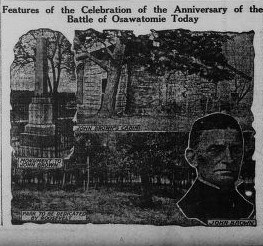Part of a series of articles titled Remembering John Brown.
Article
“An Inspiration of All Men”: Remembering John “Osawatomie” Brown in Kansas
While places around the country commemorated the 50th anniversary of the Raid on Harpers Ferry, celebrations of John Brown’s exploits had begun decades earlier in Kansas. John Brown, who had earlier dedicated his “life to the destruction of slavery,” had arrived in the Kansas Territory with other members of his family in 1855. It was here he came to the nation’s attention as a leading figure in the free-state struggle, “Bleeding Kansas,” engaging in armed struggles against slavery that not only foreshadowed the violence at Harpers Ferry, but the violence that would ultimately culminate in the Civil War.
“The friends of humanity, liberty, and of human progress in Kansas yesterday unveiled a monument to commemorate the sufferings, the life and the triumph of a martyr, whose name will never perish from the record of humanity, and whose memory will gain a luster with the passing years as one of the choicest heritages of our posterity.”
“John Brown,” St. Louis Globe Democrat, August 31, 1877.

Courtesy of Boyd B. Stutler Collection, West Virginia State Archives

Courtesy of Library of Congress
In 1877, a mere six months after Reconstruction ended, the Soldiers Monument was dedicated on the 21st anniversary of the Battle of Osawatomie. The monument was placed in the center of the graves of the “fallen soldiers” and was inscribed, “ In commemoration of those who on the 30th of August, 1856, gave up their lives at the Battle of Osawatomie in Defence [sic] of freedom.” The monument not only contained the names of the battle’s victims among which was John Brown’s son, Frederick, its north side memorialized John Brown himself. It read, “This inscription is also in commemoration of Capt. John Brown, who commanded at the Battle of Osawatomie August 20, 1856, Who Died and Conquered on the Scaffold at Charleston, Virginia, Dec. 2, 1859." Ex- Governor Charles Robinson, who presided over the ceremonies in his speech alluded to John Brown’s legacy saying, “The soul of John Brown was the inspiration of all the armies of the Union in the war, it is and will be the inspiration of all men in the struggles against tyranny. He became a traitor to the government that he might be loyal to freedom.” He then went on to draw comparisons between John Brown and Jesus Christ stating, “John Brown was deemed a traitor by men of his generation, and so was Jesus Christ. The one died to save a world from sin, the other died the savior of a race from bondage.” Other speakers heralded the bravery and patriotism of Brown and his men. Included among the speakers was African American Underground Railroad Operative, Charles Henry Langston, who in 1858 had been charged for violating the 1850 Fugitive Slave Law as part of the Oberlin-Wellington Rescue in Ohio. Langston had moved to Kansas during the Civil War. Beginning his remarks, “Fellow Citizens,” Langston drew attention to African Americans’ post-war incorporation into the body politic, and stated his purpose was to “dedicate this monument to departed greatness.” Speaking of John Brown he said, “We should cherish the memory of the hero of Osawatomie and martyr of Harper’s [sic] Ferry with admiration and love.” He further stated that even if Brown had not prematurely lost his life, “we should still have owed him a vast debt of gratitude, but when we remember his bloody capture, his farcical trial, his legal but redhanded murder, how anxious should we be to honor ourselves by honoring so great a benefactor.”[1]
Republican politician, Col. John P. St. John of Olathe, Kansas, in his speech, seemingly referencing the problematic end of Reconstruction, argued that reconciliation of the nation should not just be on the part of the north and that the struggle against slavery would remain incomplete until the south could too erect monuments honoring the "memory of John Brown." [2]
Despite being heralded by many as a hero who had put his life on the line to right a great immoral injustice, Brown’s legacy remained complicated. During a 1910 dedication of the John Brown Park, located on the Osawatomie Battle site, ex-President Theodore Roosevelt, delivering a speech on the occasion, barely mentioned Brown’s name or slavery.[3]
While John Brown monuments remain a source of pride for communities, they are still largely absent in the south save for the one at Harpers Ferry. It would therefore seem, if we are to believe the sentiments that Col. St. John delivered nearly 150 years ago, the struggle continues.
Sources
[1] “John Brown’s Body,” Leavenworth Times, September 2, 1877.
[2] "John Brown's Body."
[3]Robert S. La Forte, “Theodore Roosevelt's Osawatomie Speech,” Kansas Historical Quarterly 32.2 (1966): 187-200, https://www.kshs.org/p/kansas-historical-quarterly-theodore-roosevelt-s-osawatomie-speech/13176.
Last updated: October 20, 2020
